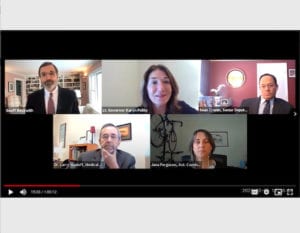Who is a member?
Our members are the local governments of Massachusetts and their elected and appointed leadership.

State and local leaders convened on Zoom to discuss COVID vaccine distribution. Pictured are (top row, l-r) MMA Executive Director Geoff Beckwith; Lt. Gov. Karyn Polito; Sean Cronin, senior deputy commissioner at the Division of Local Services; (bottom row) Dr. Larry Madoff, medical director at the Department of Public Health and Jana Ferguson, assistant commissioner at the Department of Public Health.
In the midst of a bumpy rollout of the COVID-19 vaccine program for residents age 75 and older, state and local officials today spent the bulk of their regular hour-long conference call focused on how to reach this vulnerable population and be prepared for the larger numbers in the groups to come.
Lt. Gov. Karyn Polito and Jana Ferguson, assistant commissioner at the Department of Public Health, explained the state vaccination strategy, which prioritizes the high-volume Mass Vaccination sites — currently operating in Boston (two locations), Danvers, Foxborough and Springfield — followed by regional vaccination sites, health care providers and retail pharmacy locations. State officials are seeking to keep the logistics manageable while guarding against potential waste of scarce vaccine doses.
“If every community set up a clinic, we would not have enough doses or the bandwidth to manage that,” Polito said. “We think the regional approach … is more efficient for the [COVID-19] Command Center to be able to determine how to distribute doses.”
Polito and Ferguson emphasized the efficiency of the Mass Vaccination sites, which will help the state vaccinate large populations quickly, a key ingredient to ending the pandemic.
Recognizing that residents in the 75-plus group often lack internet connectivity or the technical skills to navigate the state’s online vaccine appointment-booking system, the administration last Friday announced a new call center, accessible by dialing 2-1-1, as an alternative. But municipal officials continued to voice concerns about this vulnerable population and the insufficient supply of vaccine doses. Many want to see more vaccine sites in order to improve convenience and limit travel times, particularly for residents with limited mobility or without access to viable public transportation options.
If they’re interested in establishing a new vaccination clinic, Polito and Ferguson urged local officials to think regionally, pointing to successful examples in Franklin and Berkshire counties. Local officials can present proposals to Ferguson at DPH through their local board of health or health department. She said the department will consider the expected volume, the location in relation to other sites, and proposed operating hours, among other factors. She said a vaccine clinic needs to be able to administer between 750 and 1,500 shots per day or more, and cannot turn people away based on residency.
Thus far, roughly 200,000 of the state’s 324,000 residents in the 75-plus category have received their first shots, Polito said.
“We’ve got a little more work to do with our over-75’s before we can open up to 65-plus and people with medical conditions,” she said. “Then we’re looking at the public workforce.”
Polito said local officials, particularly local boards of health and councils on aging, have an important role to play in ensuring that the vaccine reaches those who are homebound or have limited mobility.
Ferguson added, “We really would like municipalities to focus on the really hard to reach populations,” while the state continues its work to make locations more accessible.
She said councils on aging are welcome to help residents make appointments, and vaccine doses are being allocated for local low-income and affordable senior housing.
State officials acknowledge that the supply of vaccine doses is falling considerably short of requests, in part because of production issues and the federal allocation schedule. Ferguson said that the state needs to make difficult decisions about distribution in order to keep the system running and avoid the risk of spoiled or wasted shots. The range of considerations include commitments to Mass Vaccination sites, pharmacies and hospitals; the ability of agencies to fully use their allotment; the requestor’s proximity to larger-scale sites; and the prioritization of particularly hard-hit communities.
“We can’t fill all the requests for vaccines that we receive each week,” she said. “We are getting so many more requests for vaccines than the state gets in.”
The state’s three-phase COVID vaccine plan, launched in mid-December, determines when the vaccine will become available to certain identified population groups, from COVID-facing health care workers (first up in Phase 1) to the general public (Phase 3). Following the 75-plus category are the roughly 500,000 residents between age 65 and 75, as well as individuals with two or more medical conditions that increase risk for severe illness and residents and staff of low-income and affordable senior housing. The next tier in Phase 2 includes workers in schools, transit, grocery stores, utilities, restaurants and cafes, and sanitation, public works and public health, among other categories.
Polito said there are now more than 125 public vaccine clinics, and the state is receiving 103,000 doses per week, though “our demand is four times that.”
In the event of appointment cancellations, Ferguson said, the state uses active wait lists to ensure that vaccine doses are not going to waste or delivered to individuals who don’t qualify for the current phase of the plan.
The DPH updates vaccine data online daily. The state’s central online clearinghouse, www.mass.gov/covidvaccine, provides access to the vaccine plan, identifies the various groups, maps out vaccine locations, and allows eligible visitors to make vaccine appointments.
Polito mentioned the state’s new “Trust the Facts. Get the Vax.” public awareness campaign, and noted that the state’s COVID data continues to trend in the right direction.
• Audio of Feb. 9 call with administration (36M MP3)